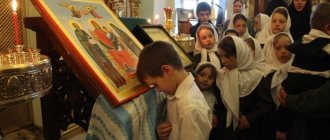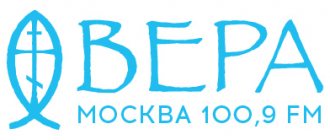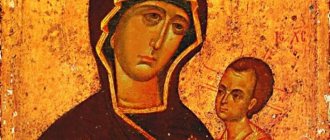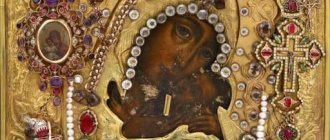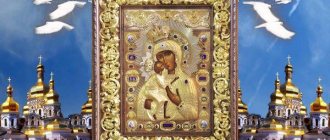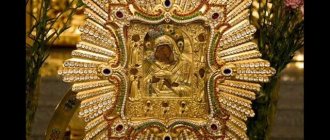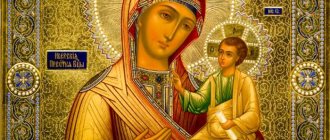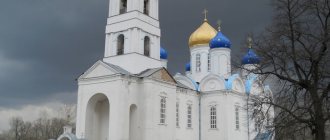Prayer to the Most Holy Theotokos before the icon of Her, called “Three-Handed”
Icon of the Mother of God “Three-Handed”
Oh, Most Holy Lady Theotokos, who showed a great miracle to Saint John of Damascus, showing true faith and undoubted hope! Hear us, sinners, before Your miraculous icon, fervently praying and asking for Your help: do not deny the prayer of many for the sake of our sins, but, as the Mother of mercy and generosity O, deliver us from illnesses, sorrows and sorrows, forgive the sins we have committed, fill us with joy and Congratulations to all who honor Your holy icon, may we joyfully sing and glorify Your name with love, for You are chosen and blessed from all generations forever and ever. Amen.
Second prayer to the Most Holy Theotokos before the icon of Her, called “Three-Handed”
Oh, Most Holy and Most Blessed Virgin, Mother of God Mary! We fall down and worship You before Your holy icon, remembering Your glorious miracle, by healing the truncated right hand of the Venerable John of Damascus, from this icon which was revealed, whose sign is dona It is not visible on it, in the form of a third hand, attached to your image. We pray to You and ask You, the All-merciful and All-generous Intercessor of our race: hear us praying to You, and like blessed John, who cried out to You in sorrow and illness, You heard , so do not despise us, those who grieve and suffer from the wounds of many different passions, do not despise , those who are diligently running to You from a contrite soul. You see, O All-Merciful Lady, our infirmities, our embitterment, our need, I will need Your help, as the enemy surrounds us from everywhere, and there is no one who helps, who stands lower, unless You are merciful about us, Lady. To her, we pray to You, listen to our painful voice and help us to preserve the patristic Orthodox faith until the end of our days blamelessly, to walk unswervingly in all the commandments of the Lord, true repentance for sins always offer them to God and be honored with a peaceful Christian death and a good answer at the terrible judgment of the Son Yours and our God. We implored Him for us with Your motherly prayer, may He not condemn us according to our iniquity, but may He have mercy on us according to His greatness and ineffable mercy. Oh, All-Good One! Hear us and do not deprive us of Your help, O sovereign, yes, having received salvation through You, let us sing and glorify You on the land of the living and our Redeemer, born of You, the Lord Jesus Christ, like Him. there is glory and power, honor and worship, together with the Father and the Holy Spirit , always, now and ever and unto ages of ages. Amen.
Why pray to the Virgin Mary
Orthodox people pray to the Most Holy Theotokos, trusting in Her help and intercession. It is She who stands closest to God. Jesus Christ especially appreciates and fulfills the requests of the Virgin Mary - His Mother. It is worth remembering the first miracle performed at a wedding in Cana of Galilee. At the request of the Mother of God, the Savior turned wine into water. The numerous miracles performed by the Mother of God most clearly testify to the motherly love of the Mother of God for believers. Orthodox Christians regard the Most Holy Theotokos as a mother. And they expect parental care from Her. We believe that the Virgin Mary will not leave her children without support and help. And the prayer “Three Hands” is one of the appeals to the Mother of God.
“When you see the icon of the Most Holy Theotokos, turn your heart to Her, the Queen of Heaven, and thank Her for the fact that She appeared so ready to submit to the will of God, that she gave birth, “nourished” and raised the Savior of the world, and that in our invisible battle Her intercession and help to us never fails” (Reverend Nicodemus the Holy Mountain).
The history of an unusual image
This is not an ordinary icon, different from other images of Hodegetria. Below it is a cast hand attached to the icon, like the third hand of the Mother of God. The story of its appearance is connected with the miracle of the Most Pure One.
According to the most common version, the appearance of the unusual icon dates back to the 8th century, but there is also an independent legend that the first such image was created much later - in the 14th century.
John of Damascus
Venerable John of Damascus Bogatenko Yakov Alekseevich (1880–1941) 1905 Wood, tempera 18 × 14.5 cm Museum of Musical Culture named after M. I. Glinka, Moscow, Russia
From the life of this monk, a rather dramatic story of the appearance of the Three-Handed One is known. St. John served at the court of the Caliph of Damascus (Syria). For his intelligence, honesty, and statesmanship, he enjoyed the respect of the ruler and the entire court. At the same time, John was a Christian, and did not hide it, although Syria was Muslim at that time.
Educated and firm in faith, Damascene (as John was called after his place of residence and service) more than once fought against the heresies that were then torn apart by the Church. Thus, from 726, the Byzantine emperor, Leo III, forbade the worship of icons, ordering them to be thrown out of their churches and destroyed. There were many doubts and hesitations among the believers. For many of them, they ended after reading the bright polemical works of John, which the Byzantines knew well. The saint logically, simply, and clearly expounded the church teaching on icon veneration.
Useful materials
Seeing that his undertakings were failing largely because of the Syrian theologian, King Leo came up with an intrigue: he ordered his scribes, copying John’s handwriting, to write a letter allegedly sent by him to the king with a proposal to open the gates of Damascus to the Byzantine troops. The king sent this “message” to the caliph as evidence of “friendship,” but in fact, trying to expose John as a traitor. Probably, the king believed that the caliph would execute his minister, but his merits turned out to be too great. Nevertheless, believing the slander, the ruler ordered John’s right hand to be beheaded.
The innocent sufferer accepted the execution without complaining to the ruler, only asking not to hang the severed limb on public display, as was customary. The severed hand was given to John. Having placed this evidence of injustice and human treachery before the icon of the Most Pure One, John, suffering from pain, prayed for the impossible: healing. The ardent faith of the defender of Orthodoxy was not disgraced: in the morning everyone saw him with their own eyes whole, healthy, with both hands. Only around the right hand there remained a noticeable red line, as evidence of a miracle.
Now the caliph, shocked to the depths of his soul, begged John for forgiveness and offered him positions higher than before. But the innocent sufferer, having forgiven the ruler’s error from the heart, decided otherwise: completely moving away from the court, he took monastic vows at the monastery of St. Savva the Sanctified. He also took the icon there, decorating it with an image of a hand cast in silver.
It is believed that the monks subsequently (XII century) presented this shrine to St. Savva Serbsky. By the 14th century The shrine ended up at the Serbian Hilandar Monastery of Mount Athos, where it remains to this day.
"For the sake of miracles"
However, the inhabitants of Hilandar themselves claim that the now famous icon was painted in the 14th century, and the third hand appeared on the image by itself. The monk who painted this image testified to this. A heavenly voice commanded him to leave the icon just like that, “for the sake of miracles, and not by nature.” Until now, church historians do not have a common opinion as to whether the Hilandar icon is the same icon of St. John, or her list, during the creation of which the mentioned miracle could have occurred.
In any case, the honest image is from the 14th century. became famous for overcoming discord among the monks who could not elect a worthy abbot. Unexpectedly, Hodegetria, who had previously been in the altar, appeared in the abbot’s place of the temple - and remains there to this day.
Miracles performed by the icon
During the existence of this icon, a huge number of cases of healing and saving human life and other miracles are known. Let's tell you more about the most famous ones.
One of the most interesting cases of a miracle is the story associated with the Hilendar monastery. The former abbot died. The monks could not agree on the appointment of a new one. Then the Queen of Heaven herself intervened in this matter. When the servants came to morning prayer the next morning, they saw that the icon of the “Three-Handed Lady” was not in its place, but was in the place of the abbot. Deciding that this was someone’s stupid prank, the monks moved the image to its place. The same thing happened the next day. In a dream, the Mother of God herself came to one of the servants and announced her desire to manage the monastery. From that very day it was ruled by the Queen of Heaven. During various wars, soldiers more than once saw the image of a woman in the sky above the monastery. This same monastery has never been destroyed or damaged in its entire history.
In the 19th century, there was a Typhus epidemic in Kyiv. After the service named “Three-Handed”, the disease retreated from the city, and people recovered. This icon is still kept in Kyiv. There is a known case when a woman arrived there. Her hand was doused with acid. After touching the icon, the wounds healed without leaving a trace.
Many miraculous acts are associated with the image
What do they pray for before this image of the Mother of God?
People address the “Three-Handed” Mother of God:
- during disasters, unjust persecutions;
- asking for the restoration of peace between people, overcoming divisions, conflicting ambitions - remembering her history on Hilandar;
- in serious illnesses;
- for any other everyday sorrows.
Why do they ask for healing in hand diseases?
The reasons for this are:
- the story of the miraculous recovery of St. John of Damascus;
- many subsequent miracles of healing hands, as evidenced by some images of the Three-Handed One - copies of the original.
For example, in the Bulgarian Troyan Monastery of the Dormition of the Virgin Mary, there is a list to which three, rather than one, arms are attached. Most likely, grateful believers brought such cast images as a commemoration of the help received.
How does the “Three-Handed” icon help?
When turning to the Mother of God, the prayer must be sincere and pure, then everything will be fulfilled according to the will of God. Most often, “Three-Handed” is asked to protect family and home. The following requests are also made:
- about luck and happiness in marriage;
- about health and healing of diseases and injuries;
- about the health of loved ones and relatives;
- about the well-being of the family;
- about strengthening mental strength;
- about help and good luck in your work.
When turning to the Mother of God, prayer must be sincere and pure
Prayer to the “Three Hands”
Prayer to the icon of the Mother of God “Three Hands”
Oh, Most Holy Lady and Lady Theotokos, who showed a great miracle to Saint John of Damascus, as if he showed true faith - undoubted hope! Hear us, sinners, before Your miraculous icon, fervently praying and asking for Your help: do not reject this prayer of many for the sake of our sins, but, as the Mother of mercy and generosity, deliver us from illnesses, sorrows and sorrows, forgive the sins we have committed, fill us with joy and joy to all who honor Your holy icon, may we joyfully sing and glorify Your name with love, for You are chosen and blessed from all generations forever and ever. Amen.
Troparion
Today, great worldwide joy has arisen for us: Thy celibate-bearing icon has been given to the holy Mount Athos, the Lady Theotokos, with the image of Thy three-numbered and indivisibly most pure hands, for the glorification of the Holy Trinity, calling for the faithful and those who pray to You to know this, as two imashes you hold the Son and the Lord , the third, show as a refuge and protection to those who honor You from all misfortunes and troubles, so that all who flow to You by faith, receive abundant liberation from all evils, protection from enemies, for this sake we, together with Athos, cry out: Rejoice, Gracious One, Lord with you.
Kontakion
Today is the joyful day of Your triumph, O Most Pure Mother of God, all the faithful are filled with joy and joy, as if you were worthy to fairly sing the wondrous appearance of Your honorable image and the Child born of You, the truth of God, Who embraced His two hands, and with the third took us away from misfortunes and troubles and deliver you from all evils and circumstances.
Amulet for a long journey
To make a long journey safe, you need to cast a special amulet on your car. To do this, buy a small icon (laminated) and a wax candle from the church. In the garage, walk around your car three times with a lit church candle. You also need to read the special amulet for your car three times:
Protective words can be read by recording. As soon as you read the plot three times, put out the candle with your fingers (you cannot blow it out) and wrap the candle in a sheet with the written plot. Place the sheet in the glove compartment or other place in the car.
This rite will guard the path only once. After the journey, you need to burn the cinder to the end in front of the icon and thank the Mother of God for her help in saving you from an accident and other vicissitudes of a long journey. The ritual must be repeated on the next long journey.
In which Moscow churches can you find this icon?
The first “Three-Handed” icon was delivered to Russia in 1661. The copy was made on Mount Athos at the request of Patriarch Nikon. During the revolution, the icon was lost, but there are two churches where copies of it are kept. This:
- Cathedral Church of the Holy Trinity in the Danilov Monastery (Danilovsky Val St., 22, Moscow);
- the so-called “Bulgarian Compound” is the Church of the Assumption of the Virgin Mary in Gonchary (Goncharnaya St., 29/7с1, Moscow) belonging to the Bulgarian Church.
There is also a list of the shrine made in 1854. It can be seen in the New Jerusalem Museum.
